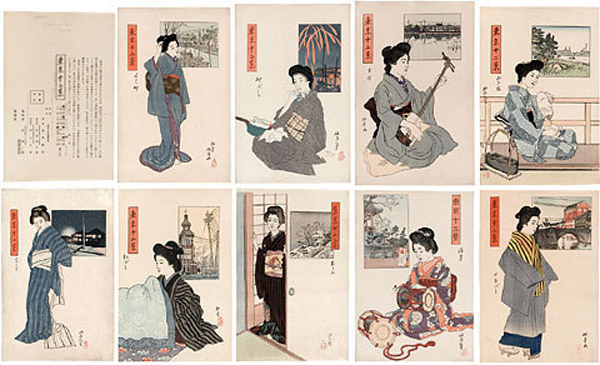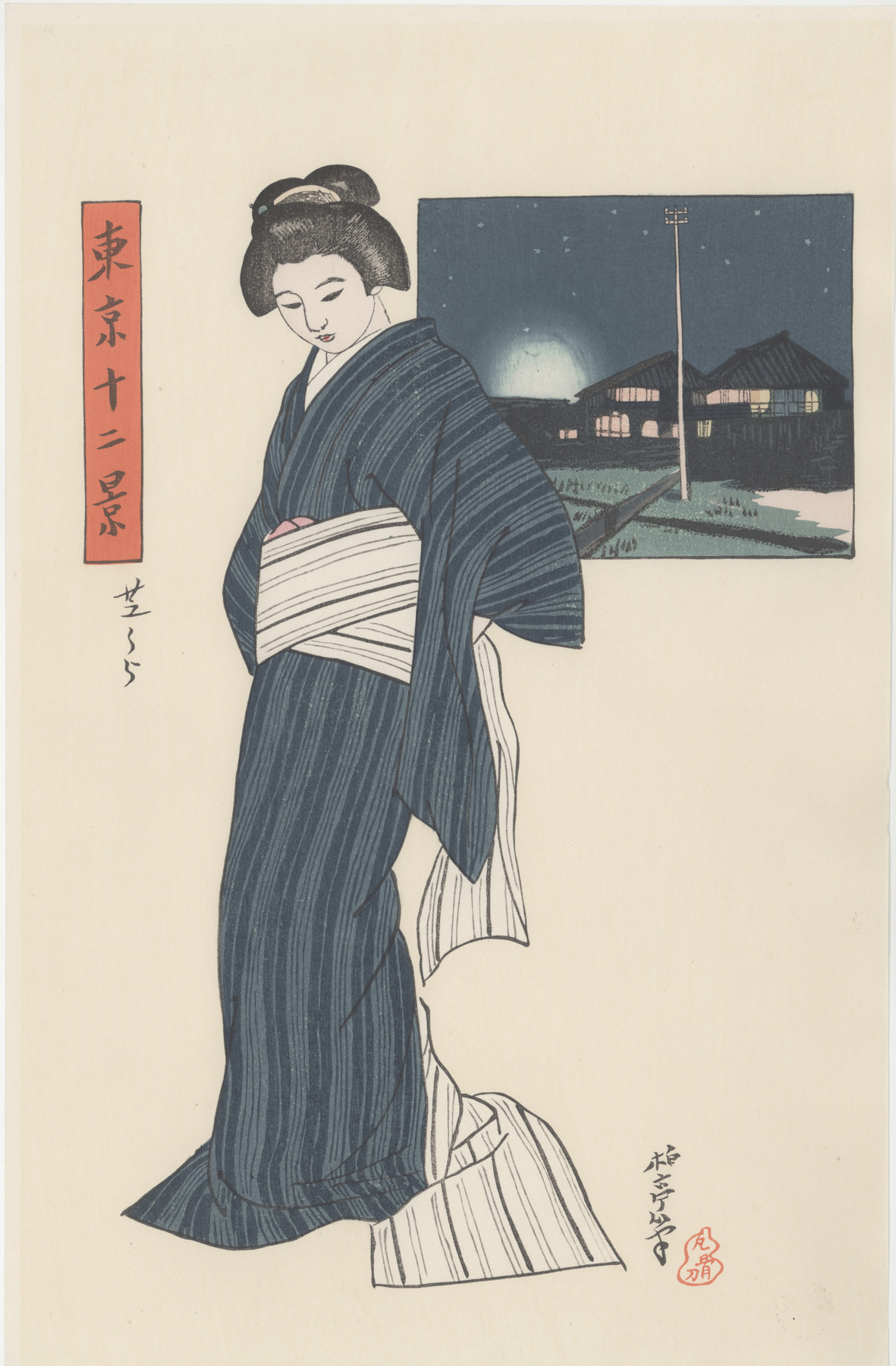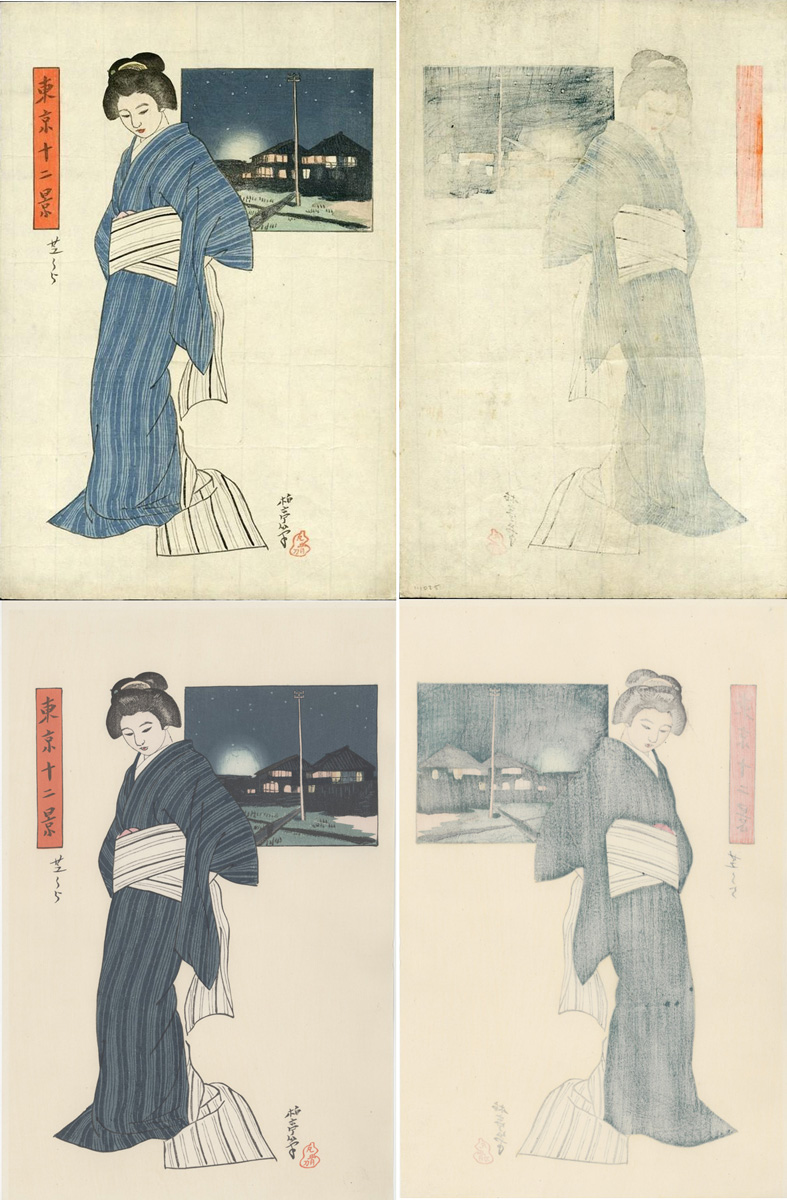About This Print
This print is likely a reprint, date unknown, of the original c. 1914-1917 issue. It is one of nine prints in the series Twelve Views of Tokyo. Picturing teahouses in the Shibaura district of Tokyo in the inset, along with a kimono-clad woman (most likely a geisha), it, along with other prints in the series, combines elements of ukiyo-e with modern realism. As further explained below, the series was ended before its completion due to its unpopularity.The Shibaura district, created on reclaimed land from Tokyo Bay, was, by Ishii's day, on its way to becoming one of Tokyo's first industrial zones and loosing its reputation for a place where, in the words of the novelist Osanai Kaoru, "the geisha came, the genuine sort, for delicious assignations."1

About The Series Twelve Views of Tokyo
Source: Modern Japanese Woodblock Prints - The Early Years, Helen Merritt, University of Hawaii Press, 1998, p. 274-276; Modern Japanese Prints 1912-1989, Lawrence Smith, British Museum Press, 1994, p. 41-42 and as footnoted.
Originally planned to encompass twelve designs, the artist Ishii Hakutei discontinued the series after nine prints, most likely due to its unpopularity. The first two designs, Yoshichō and Yanagibashi, were published by the poet and sculptor Takamura Kōtarō 高村光太郎 (1883-1956) through his picture gallery Rōkandō in 1910. The remaining seven designs, created after Ishii's return from one of his European trips in 1914, were published by Nakajima Jūtarō 中島 重太郎 proprietor of Yanagiya Shoten. The three designs that had been planned but never created were Kanda, Fukagawa and Ushigomi.
Each print in the series combines the same elements, an inset with a view of the district named in the print's title, a kimono-clad woman and a vertical cartouche with the name of the series 東京十二景 all on a blank background, reminiscent of earlier ukiyo-e works. The artist and print scholar Tadashige Ono (1909-1990) traces the use of background cartouches, as used in this series, to ukiyo-e print designers of the later Edo period such as Keisai Eisen (1790-1848) and Utagawa Kunisada I (1786–1865).
Lawrence Smith in discussing this series notes that Ishii's purpose in creating this series was to "revive in a more modern style the glories of the Ukiyo-e prints of the eighteenth and nineteenth centuries." In an August 1910 advertisement for this series appearing in the magazine Hōsun, Ishii wrote:
In creating the prints, Ishii relied upon the carver Igami Bonkotsu (1875-1933), who had extensive experience in the ukiyo-e style of carving, rather than upon his own carving skills. Working with Igami, Ishii kept tight control over the production process, in keeping with the sensibility of the sosaku hanga movement.
TheJapanese woodblock print has only become a skillful trick, and the artists haveforgotten about its characteristics. Theuseless competition to produce three-colour works, etc. brings it graduallycloser to its demise. Edo-e, which was once sumptuously adornedas a result of the cooperation between print master, printer and carver, hasdisappeared from print shops. We cannotbe bothered to look at the period of decline of this printing style that oncewas the pride of Japan. The publishingof Tōkyō jūnikie represents a moveback to the original features of a Japanese woodblock print.2
The Entire Series

clockwise from upper left: series colophon, Yoshichō よし町 (1910), Yanagibashi (1910); Shitaya 下谷, Mukōjima 向じ満,
Shibaura しばうら, Shinbashi 新ばし, Akasaka 赤さか, Asakusa 淺草, Nihonbashi 日本ばし
A reprint? - comparison between original print and this collection's print
1 Low City, High City: Tokyo from Edo to The Earthquake, Edward Seidensticker, Alfred A. Knopf, 1983, p. 227.
2 The Female Image: 20th Century Prints of Japanese Beauties, Amy Riegle Newland and Hamanaka Shinji, Abe Publishing Ltd and Hotei Publishing, 2000, p. 16, fn 8.
Print Details
| IHL Catalog | #1229 |
| Title | Shibaura (しばうら) |
| Series | Twelve Views of Tokyo 東京十二景 Tōkyō jūnikei |
| Artist | Ishii Hakutei (1882-1958) |
| Signature |  |
| Seal of Artist | none (see Carver below for information on double-gourd red seal to the right of Hakutei's signature) |
| Publication Date | originally c. 1914-1917; this reprint unknown |
| Edition | likely reprint |
| Publisher | originally Nakajima Jūtarō 中島 重太郎 of the firm Yanagiya Shoten 柳家書店, Seikadō 青果堂 [Marks: pub. ref. 368] This reprint's publisher unknown. |
| Carver |  凡骨刀 Bonkotsu tō seal of the carver Igami Bonkotsu 伊上凡骨 (1877-1933) |
| Impression | excellent |
| Colors | excellent |
| Condition | excellent |
| Genre | sosaku hanga (creative print) |
| Miscellaneous | |
| Format | ōban |
| H x W Paper | 16 3/4 x 10 7/8 in. (42.5 x 27.6 cm) |
| H x W Image | 16 7/16 x 10 9/16 in. (41.8 x 26.8 cm) |
| Collections This Print | Carnegie Museum of Art 89.28.451 (original printing); Minneapolis Institute of Art 2002.161.65.1 (original printing); University of Pennsylvania, Fine Arts Library n2006010224 (original printing) |
| Reference Literature | The Female Image: 20th Century Prints of Japanese Beauties, Amy Riegle Newland and Hamanaka Shinji, Abe Publishing Ltd and Hotei Publishing, 2000, fig. 5, p. 35; Modern Japanese Prints: The Twentieth Century, Amanda T. Zehnder, Carnegie Museum of Art, 2009, p. 54. |



